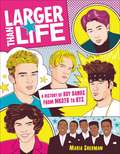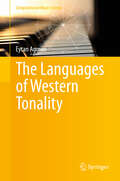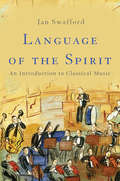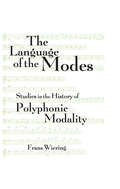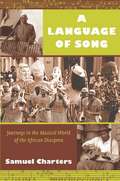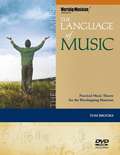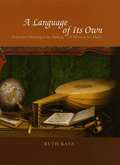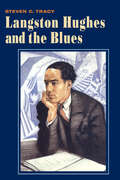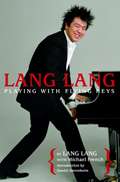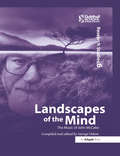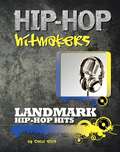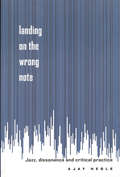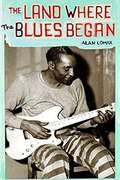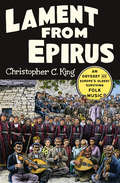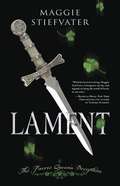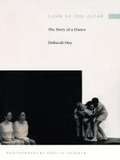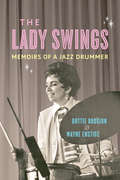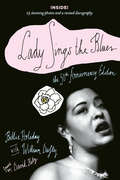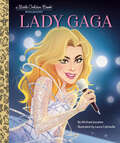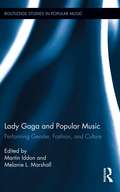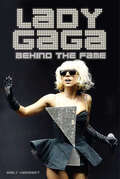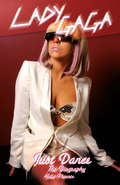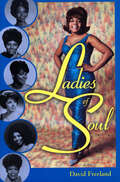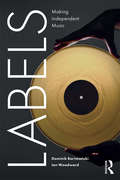- Table View
- List View
Larger Than Life: A History of Boy Bands from NKOTB to BTS
by Maria Shermanp.p1 {margin: 0.0px 0.0px 0.0px 0.0px; font: 14.0px Calibri} p.p2 {margin: 0.0px 0.0px 0.0px 0.0px; font: 14.0px Calibri; min-height: 17.0px} This nostalgic, fully-illustrated history of boy bands -- written by culture critic and boy band stan Maria Sherman -- is a must-have for diehard fans of the genre and beyond.The music, the fans, the choreography, the clothes, the merch, the hair. Long after Beatlemania came and went, a new unstoppable boy band era emerged. Fueled by good looks and even greater hooks, the pop phenomenon that dominated the '80s, '90s, and 2000s has left a long-lasting mark on culture, and it's time we celebrate it. Written by super fan Maria Sherman for stans and curious parties alike, Larger Than Life is the definitive guide to boy bands, delivered with a mix of serious obsession and tongue-in-cheek humor.Larger Than Life begins with a brief history of male vocal groups, spotlighting The Beatles, the Jackson 5, and Menudo before diving into the building blocks of these beloved acts in "Boy Bands 101." She also focuses on artists like New Edition, New Kids on the Block, Backstreet Boys, *NSYNC, One Direction, and BTS before ending with an interrogation into the future of boy bands. Included throughout are Tiger Beat-inspired illustrations, capsule histories of the swoon-iest groups, in-depth investigations into one-hit wonders, and sidebars dedicated to conspiracy theories, dating, in-fighting, haters, fan fiction, fashion (Justin and Britney in denim, of course), and so much more.Informative, affectionate, funny, and never, ever fan-shaming, Larger Than Life is the first and only text of its kind: the ultimate celebration of boy bands and proof that this once maligned music can never go unappreciated.
The Languages of Western Tonality
by Eytan AgmonTonal music, from a historical perspective, is far from homogenous; yet an enduring feature is a background "diatonic" system of exactly seven notes orderable cyclically by fifth. What is the source of the durability of the diatonic system, the octave of which is representable in terms of two particular integers, namely 12 and 7? And how is this durability consistent with the equally remarkable variety of musical styles -- or languages -- that the history of Western tonal music has taught us exist? This book is an attempt to answer these questions. Using mathematical tools to describe and explain the Western musical system as a highly sophisticated communication system, this theoretical, historical, and cognitive study is unprecedented in scope and depth. The author engages in intense dialogue with 1000 years of music-theoretical thinking, offering answers to some of the most enduring questions concerning Western tonality. The book is divided into two main parts, both governed by the communicative premise. Part I studies proto-tonality, the background system of notes prior to the selection of a privileged note known as "final. " After some preliminaries that concern consonance and chromaticism, Part II begins with the notion "mode. " A mode is "dyadic" or "triadic," depending on its "nucleus. " Further, a "key" is a special type of "semi-key" which is a special type of mode. Different combinations of these categories account for tonal variety. Ninth-century music, for example, is a tonal language of dyadic modes, while seventeenth-century music is a language of triadic semi-keys. While portions of the book are characterized by abstraction and formal rigor, more suitable for expert readers, it will also be of value to anyone intrigued by the tonal phenomenon at large, including music theorists, musicologists, and music-cognition researchers. The content is supported by a general index, a list of definitions, a list of notation used, and two appendices providing the basic mathematical background.
Language of the Spirit: An Introduction to Classical Music
by Jan SwaffordFor many of us, classical music is something serious-something we study in school, something played by cultivated musicians at fancy gatherings. In Language of the Spirit, renowned music scholar Jan Swafford argues that we have it all wrong: classical music has something for everyone and is accessible to all. Ranging from Gregorian chant to Handel's Messiah, from Vivaldi's The Four Seasons to the postmodern work of Philip Glass, Swafford is an affable and expert guide to the genre. He traces the history of Western music, introduces readers to the most important composers and compositions, and explains the underlying structure and logic of their music.Language of the Spirit is essential reading for anyone who has ever wished to know more about this sublime art.
The Language of the Modes: Studies in the History of Polyphonic Modality (Criticism And Analysis Of Early Music Ser.)
by Frans WieringThe Language of the Modes provides a study of modes in early music through eight essays, each dealing with a different aspects of modality. The volume codifies all known theoretical references to mode, all modally ordered musical sources, and all modally cyclic compositions. For many music students and listeners, the "language of the modes" is a deep mystery, accustomed as we are to centuries of modern harmony. Wiering demystifies the modal world, showing how composers and performers were able to use this structure to create compelling and beautiful works. This book will be an invaluable source to scholars of early music and music theory. in early music through eight essays, each dealing with a different aspects of modality. It codifies all known theoretical references to mode, all modally ordered musical sources, and all modally cyclic compositions. This book will be an invaluable source to scholars of early music.
A Language of Song: Journeys in the Musical World of the African Diaspora
by Samuel ChartersIn A Language of Song, Samuel Charters--one of the pioneering collectors of African American music--writes of a trip to West Africa where he found "a gathering of cultures and a continuing history that lay behind the flood of musical expression [he] encountered everywhere . . . from Brazil to Cuba, to Trinidad, to New Orleans, to the Bahamas, to dance halls of west Louisiana and the great churches of Harlem. " In this book, Charters takes readers along to those and other places, including Jamaica and the Georgia Sea Islands, as he recounts experiences from a half-century spent following, documenting, recording, and writing about the Africa-influenced music of the United States, Brazil, and the Caribbean. Each of the book's fourteen chapters is a vivid rendering of a particular location that Charters visited. While music is always his focus, the book is filled with details about individuals, history, landscape, and culture. In first-person narratives, Charters relates voyages including a trip to the St. Louis home of the legendary ragtime composer Scott Joplin and the journey to West Africa, where he met a man who performed an hours-long song about the Europeans' first colonial conquests in Gambia. Throughout the book, Charters traces the persistence of African musical culture despite slavery, as well as the influence of slaves' songs on subsequent musical forms. In evocative prose, he relates a lifetime of travel and research, listening to brass bands in New Orleans; investigating the emergence of reggae, ska, and rock-steady music in Jamaica's dancehalls; and exploring the history of Afro-Cuban music through the life of the jazz musician Bebo Valds. A Language of Song is a unique expedition led by one of music's most observant and well-traveled explorers.
The Language of Music: Practical Music Theory for the Worshipping Musician (Worship Musician Presents Series)
by Tom BrooksIn The Language of Music, Tom Brooks demystifies and explains the basic building blocks of music in a simple, clear, straightforward way – essential knowledge that every worship musician needs to perfect his craft. The book offers a practical, real-world approach to all the fundamental concepts; music theory and harmony, chord construction, scales, key signatures, chord relationships, transposition, modulation, chart reading, and basic arranging, along with tips on how to practice more efficiently and rehearse more effectively, and much more. The focus is on contemporary praise and worship; music that is inspiring the church in the 21st century.
A Language of Its Own: Sense and Meaning in the Making of Western Art Music
by Ruth KatzThe Western musical tradition has produced not only music, but also countless writings about music that remain in continuous- and enormously influential- dialogue with their subject. With sweeping scope and philosophical depth, A Language of Its Own traces the past millennium of this ongoing exchange. Ruth Katz argues that the indispensable relationship between intellectual production and musical creation gave rise to the Western conception of music. This evolving and sometimes conflicted process, in turn, shaped the art form itself. As ideas entered music from the contexts in which it existed, its internal language developed in tandem with shifts in intellectual and social history. Katz explores how this infrastructure allowed music to explain itself from within, creating a self-referential and rational foundation that has begun to erode in recent years. A magisterial exploration of a frequently overlooked intersection of Western art and philosophy, A Language of Its Own restores music to its rightful place in the history of ideas.
Langston Hughes and the Blues
by Steven C. TracyThe shades and structures of the blues had an immense impact on the poetry of Langston Hughes. Steven C. Tracy provides a cultural context for Hughes’s work while revealing how Hughes mined Black oral and literary traditions to create his poetry. Comparing Hughes’s poems to blues texts, Tracy reveals how Hughes’s experimental forms reflect the poetics, structures, rhythms, and musical techniques of the music. Tracy also offers a discography of recordings by the artists--Bessie Smith, Ma Rainey, Blind Lemon Jefferson, and others--who most influenced the poet.
Lang Lang: Playing with Flying Keys
by Lang Lang Michael FrenchLang Lang started learning to play the piano when he was three years old in Shenyang, China. Today he is one of the world’s most outstanding pianists. In this engrossing life story, adapted by Michael French, Lang Lang not only recounts the difficult, often thrilling, events of his early days, but also shares his perspective on his rapidly changing homeland. He thoughtfully explores the differences between East and West, especially in the realm of classical music and cultural life. Shining through hi...
Landscapes of the Mind: The Music of John McCabe
by George OdamLiverpool-born composer and pianist, John McCabe, established himself as one of Britain's most recorded contemporary composers as well as a celebrated performer and recording artist. This book covers every aspect of his compositions and will help guide both general and specialist listeners and performers through the so-called landscapes of the mind that his music evokes. The title was suggested by McCabe himself and his composing and performing life took him on journeys all over the world through a variety of landscapes, many of which are to be found in essence in his music. The detailed discography will help readers to find recordings of many of the works described in the series of articles written by a collection of experienced critics, performers, broadcasters and reviewers, and the copious illustrations and full pages of musical score provide a variety of insights into McCabe's life and work.
Landmark Hip Hop Hits (Hip-Hop Hitmakers)
by Carol EllisHip-hop music began in the neighborhoods of the Bronx, New York, during the 1970s and grew to become a major cultural influence all over the world. Hip-hop has evolved through both individual innovation and technological breakthroughs. Landmark Hip-Hop Hits traces the development of this musical genre through discussion of its biggest hits and most important stars, from early songs like "Rapper's Delight" and "The Message" to contemporary hits by performers like Jay-Z, Drake, Eminem, Nicki Minaj, and Lil Wayne. The songs discussed in this book had an important part to play in shaping the history of the hip-hop movement over the past five decades.
Landing on the Wrong Note: Jazz, Dissonance, and Critical Practice
by Ajay HebleAn imaginative and passionate synthesis of form and function, Landing on the Wrong NOte goes beyond mainstream jazz criticism, outlining a new poetics of jazz that emerges not from the ivory tower but from the clubs, performances, and lives of today's jazz musicians.
The Land Where The Blues Began
by Alan LomaxA self-described "song-hunter" the folklorist Alan Lomax traveled the Mississippi Delta in the 1930s and 40s armed with primitive recording equipment and a keen love of the Delta's music heritage. Crisscrossing the towns and hamlets where the blues began, Lomax gave voice to such greats as Leadbelly, Fred MacDowell, Muddy Waters, and many others, all of whom made their debut recordings with him.
Lament from Epirus: An Odyssey Into Europe's Oldest Surviving Folk Music
by Christopher C. KingIn the tradition of Patrick Leigh Fermor and Geoff Dyer, a Grammy-winning producer discovers a powerful and ancient folk music tradition. In a gramophone shop in Istanbul, renowned record collector Christopher C. King uncovered some of the strangest—and most hypnotic—sounds he had ever heard. The 78s were immensely moving, seeming to tap into a primal well of emotion inaccessible through contemporary music. The songs, King learned, were from Epirus, an area straddling southern Albania and northwestern Greece and boasting a folk tradition extending back to the pre-Homeric era. To hear this music is to hear the past. Lament from Epirus is an unforgettable journey into a musical obsession, which traces a unique genre back to the roots of song itself. As King hunts for two long-lost virtuosos—one of whom may have committed a murder—he also tells the story of the Roma people who pioneered Epirotic folk music and their descendants who continue the tradition today. King discovers clues to his most profound questions about the function of music in the history of humanity: What is the relationship between music and language? Why do we organize sound as music? Is music superfluous, a mere form of entertainment, or could it be a tool for survival? King’s journey becomes an investigation into song and dance’s role as a means of spiritual healing—and what that may reveal about music’s evolutionary origins.
Lament: The Faerie Queen’s Deception (Books of Faerie #1)
by Maggie StiefvaterA dark faerie fantasy that features authentic Celtic faerie lore, "Lament" follows 16-year-old Dierdre Monaghan, who discovers that she is a cloverhand -- one who can see faeries. Dierdre soon finds herself trapped in the middle of a centuries-old faerie war.
Lamb at the Altar: The Story of a Dance
by Deborah Hay"The intention of my work is to dislodge assumptions about the fixity of the three-dimensional body."--Deborah HayHer movements are uncharacteristic, her words subversive, her dances unlike anything done before--and this is the story of how it all works. A founding member of the famed Judson Dance Theater and a past performer in the Merce Cunningham Dance Company, Deborah Hay is well known for choreographing works using large groups of trained and untrained dancers whose surprising combinations test the limits of the art. Lamb at the Altar is Hay's account of a four-month seminar on movement and performance held in Austin, Texas, in 1991. There, forty-four trained and untrained dancers became the human laboratory for Hay's creation of the dance Lamb, lamb, lamb . . . , a work that she later distilled into an evening-length solo piece, Lamb at the Altar. In her book, in part a reflection on her life as a dancer and choreographer, Hay tells how this dance came to be. She includes a movement libretto (a prose dance score) and numerous photographs by Phyllis Liedeker documenting the dance's four-month emergence.In an original style that has marked her teaching and writing, Hay describes her thoughts as the dance progresses, commenting on the process and on the work itself, and ultimately creating a remarkable document on the movements--precise and mysterious, mental and physical--that go into the making of a dance. Having replaced traditional movement technique with a form she calls a performance meditation practice, Hay describes how dance is enlivened, as is each living moment, by the perception of dying and then involves a freeing of this perception from emotional, psychological, clinical, and cultural attitudes into movement. Lamb at the Altar tells the story of this process as specifically practiced in the creation of a single piece.
The Lady Swings: Memoirs of a Jazz Drummer (Music in American Life #543)
by Dottie Dodgion Wayne EnsticeDottie Dodgion is a jazz drummer who played with the best. A survivor, she lived an entire lifetime before she was seventeen. Undeterred by hardships she defied the odds and earned a seat as a woman in the exclusive men’s club of jazz. Her dues-paying path as a musician took her from early work with Charles Mingus to being hired by Benny Goodman at Basin Street East on her first day in New York. From there she broke new ground as a woman who played a “man’s instrument” in first-string, all-male New York City jazz bands. Her inspiring memoir talks frankly about her music and the challenges she faced, and shines a light into the jazz world of the 1960s and 1970s. Vivid and always entertaining, The Lady Swings tells Dottie Dodgion's story with the same verve and straight-ahead honesty that powered her playing.
Lady Sings the Blues: The 50th-Anniversay Edition with a Revised Discography (Harlem Moon Classics)
by David Ritz Billie Holiday William DuftyWith photosOriginally released by Doubleday in 1956, Harlem Moon Classics celebrates the publication with the fiftieth-anniversary edition of Billie Holiday's unforgettable and timeless memoir. Updated with an insightful introduction and a revised discography, both written by celebrated music writer David Ritz.Lady Sings the Blues is the fiercely honest, no-holds-barred autobiography of Billie Holiday, the legendary jazz, swing, and standards singing sensation. Taking the reader on a fast-moving journey from Holiday's rough-and-tumble Baltimore childhood (where she ran errands at a whorehouse in exchange for the chance to listen to Louis Armstrong and Bessie Smith albums), to her emergence on Harlem's club scene, to sold-out performances with the Count Basie Orchestra and with Artie Shaw and his band, this revelatory memoir is notable for its trenchant observations on the racism that darkened Billie's life and the heroin addiction that ended it too soon. We are with her during the mesmerizing debut of "Strange Fruit"; with her as she rubs shoulders with the biggest movie stars and musicians of the day (Bob Hope, Lana Turner, Clark Gable, Benny Goodman, Lester Young, Coleman Hawkins, and more); and with her through the scrapes with Jim Crow, spats with Sarah Vaughan, ignominious jailings, and tragic decline. All of this is told in Holiday's tart, streetwise style and hip patois that makes it read as if it were written yesterday.
Lady Gaga: A Little Golden Book Biography (Little Golden Book)
by Michael JoostenHelp your little one dream big with a Little Golden Book biography about pop music icon, actress, and philanthropist Lady Gaga. Little Golden Book biographies are the perfect introduction to nonfiction for young readers—as well as fans of all ages!This Little Golden Book about Lady Gaga--the genre-straddling singer of hits including "Born This Way" and "Shallow" and star of House of Gucci and A Star is Born--is an inspiring read-aloud for young children and their parents who are fans. Look for more Little Golden Book biographies: • Willie Nelson • Beyoncé • Dolly Parton • Taylor Swift • Tony Bennett
Lady Gaga and Popular Music: Performing Gender, Fashion, and Culture (Routledge Studies in Popular Music)
by Martin Iddon Melanie L. MarshallThis book is a multi-faceted, interdisciplinary examination of the music and figure of Lady Gaga, combining approaches from scholars in cultural studies, art, fashion, and music. It represents one of the first scholarly volumes devoted to Lady Gaga, who has become, over a few short years, central to both popular (and, indeed, populist) as well as more scholarly thought in these areas and who, the contributors argue, is helping to shape—directly and indirectly—thought and culture both in the fields of the "scholarly" and the "everyday." <P><P> Lady Gaga's output is firmly embedded in a self-consciously intellectual pop culture tradition, and her music videos are intertextually linked to icons of pop culture intelligentsia like Alfred Hitchcock and open to multiple interpretations. In examining her music and figure, this volume contributes both to debates on the status of intertextuality, held in tension with originality, and to debates on the figuring of the sexualized female body, and representations of disability. There is interest in these issues from a wide range of disciplines: popular musicology, film studies, queer studies, women’s studies, gender studies, disability studies, popular culture studies, and the burgeoning sub-discipline of aesthetics and philosophy of fashion.
Lady Gaga: Behind the Fame
by Emily HerbertQueen of Pop, superstar, maverick and fashionista; Lady Gaga is one of the most recognizable and sensational pop stars for a generation. A true original, Gaga found fame the hard way, playing the grimy bars and burlesque shows of New York City, before finally relocating to Los Angeles to begin work on what would become her debut album The Fame. Constantly en vogue and always in the public eye, this is the biography of the rise of Gaga, from her early life as a teenage protégé, to her life as one of the most respected musicians and most recognized entertainers on the planet. This book lifts the lid on Lady Gaga. Find out all you ever wanted to know about the eccentric star.
Lady Gaga: The Biography
by Helia PhoenixWe're all going gaga for Gaga. The first biography of the international superstar, style icon and pop princess...Pop princess. Fashionista. Icon. Rebel. Eccentric. Superstar.She's known all over the world for her catchy music, outlandish style and often controversial opinions. A paparazzi favourite, she manages to grab headlines whilst remaining enigmatic. Whether she's carrying a purple teacup, fuelling the fire about her gender or stealing the limelight with her creative performances, no one can deny this twenty-first-century sensation is turning heads wherever she goes. She is Lady Gaga.But Stefani Joanne Angelina Germanotta was always destined to be a star. Just Dance is the first unauthorised biography to reveal how she achieved popworld domination to become one of the globe's most exciting new entertainers - an artist who constantly pushes the boundaries of music, fashion and culture. Find out why we're all going gaga for Gaga...
Lady Gaga: Just Dance: The Biography
by Helia PhoenixWe're all going gaga for Gaga. The first biography of the international superstar, style icon and pop princess...Pop princess. Fashionista. Icon. Rebel. Eccentric. Superstar.She's known all over the world for her catchy music, outlandish style and often controversial opinions. A paparazzi favourite, she manages to grab headlines whilst remaining enigmatic. Whether she's carrying a purple teacup, fuelling the fire about her gender or stealing the limelight with her creative performances, no one can deny this twenty-first-century sensation is turning heads wherever she goes. She is Lady Gaga.But Stefani Joanne Angelina Germanotta was always destined to be a star. Just Dance is the first unauthorised biography to reveal how she achieved popworld domination to become one of the globe's most exciting new entertainers - an artist who constantly pushes the boundaries of music, fashion and culture. Find out why we're all going gaga for Gaga...
Ladies of Soul
by David FreelandAmerican soul music of the 1960s is one of the most creative and influential musical forms of the twentieth century. With its merging of gospel, R&B, country, and blues, soul music succeeded in crossing over from African American culture into the general pop culture. Soul became the byword for the styles, attitudes, and dreams of an entire era. Female performers were responsible for some of the most enduring and powerful contributions to the genre. All too frequently overlooked by the star-making critics, seven of these women are profiled in this book -Maxine Brown, Ruby Johnson, Denise LaSalle, Bettye LaVette, Barbara Mason, Carla Thomas, and Timi Yuro. Getting started during the heyday of soul, each of these talented women had recording contracts and gave live performances to appreciative audiences. Their careers can be tracked through the popularity of soul during the 1960s and its decline in the 1970s. With humor, candor, pride, and honest recognition that their careers did not surge into the mainstream and gain superstardom, they recount individual stories of how they struggled for success. Their oral histories as told to David Freeland address compelling issues, including racism and sexism within the music industry. They discuss their grueling hardships on the road, their conflicts with male managers, and the cutthroat competition in the recording business. As each singer examines her career with the author, she reveals the dreams, hopes, and desires on which she has built her professional life. All seven face up to the career swings, from the highs of releasing the first hit to the frustrating lows when the momentum stops. Although the obstacles to stardom are heartbreaking, these singers are committed to their art. With determination and style these seven have pressed onward with club appearances and recordings. They survive through their savvy mix of talent, hubris, and honesty about their lives and their music.
Labels: Making Independent Music (Criminal Practice Ser.)
by Ian Woodward Dominik BartmanskiThe music industry is dominated today by three companies. Outside of it, thousands of small independent record labels have developed despite the fact that digitalization made record sales barely profitable. How can those outsiders not only survive, but thrive within mass music markets? What makes them meaningful, and to whom? Dominik Bartmanski and Ian Woodward show how labels act as taste-makers and scene-markers that not only curate music, but project cultural values which challenge the mainstream capitalist music industry. Focusing mostly on labels that entered independent electronic music after 2000, the authors reconstruct their aesthetics and ethics. The book draws on multiple interviews with labels such as Ostgut Ton in Berlin, Argot in Chicago, 100% Silk in Los Angeles, Ninja Tune in London, and Goma Gringa in Sao Paulo. Written by the authors of Vinyl, this book is essential reading for anyone with an interest in the contemporary recording industry, independent music, material culture, anthropology, sociology, and cultural studies.
